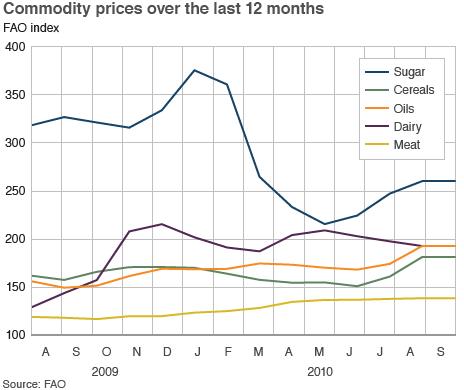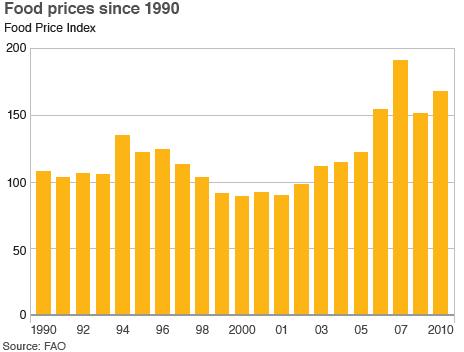Food price rises are growing concern
- Published

Forecasts for the global rice crop have been revised following the devastating floods in Pakistan
Food prices are back on the menu.
It is not a crisis on the scale of 2008, but it is a growing concern and the United Nations' Food and Agriculture Organization (FAO) has convened a special meeting in Rome to discuss the issue.
The FAO produces monthly index of food prices, based on international commodity markets.
It is not taken from the prices consumers actually pay, but it does give an indication of the direction that retail prices are likely to move.
The index hit its all time high in June 2008. Over the following eight months, it fell back sharply, by more than a third.
But it is on its way back up again. The latest figure, for August, is 26% up from last year's low.

Upward trend
And even that trough was not cheap at all by the standards of the past two decades. It was consistently below that level until April 2007.
All the main food types in the FAO index are up from the levels of a year ago, with the exception of sugar. And within cereals, rice is lower although it has started to gain since May.
But the general trend is upwards. The rise is particularly strong for dairy produce and the meat price index is at its highest ever.
The figures do not yet capture what has happened in commodity markets over the past few weeks. There have been some further rises in some markets.
Hitting the poor
Overall, the FAO describes the cost of staple foods as "stubbornly high". And the agency says the financial crisis is "straining the ability of the poor to cope".
There are several factors at play.
The economic recovery after the financial crisis has helped revive demand for food.
In the rich countries, the recovery is not particularly strong, but many developing economies are growing robustly. Rising incomes in those countries are fuelling increased meat consumption.
That affects the prices of both meat and the grains used as animal feed.

Hidden dangers
The market for grains, in particular wheat, has also been affected on the supply side.
The drought in Russia and the government's decision to restrict wheat exports have had a large impact. The floods in Pakistan have also affected forecasts for the global rice crop.
But the FAO does not think the situation qualifies as a crisis.
The agency's assistant director general, Hafez Ghanem, says: "This year's cereal harvest was the third highest on record and stocks are high."
But he does have a warning: "The picture could change if there is another shock to supply, for example, due to more bad weather, or if government policies lead to increased anxiety in the market, provoking panic buying."
He also thinks that the long-term outlook is one of more turbulence.
He gives three reasons:
the Black Sea region is becoming increasingly important in grain markets and yields there tend to fluctuate a great deal
more frequent extreme weather due to climate change
and the growing importance of what he calls non-commercial actors in commodity markets.
That probably means financial market investors, including speculators.
He says the international community, led by the G20, should respond with better regulation and emergency food stocks.
So the message seems to be, don't panic, at least not now, but keep a wary eye on the food market now and in the coming years.
- Published6 August 2010
- Published19 July 2010
- Published3 September 2010